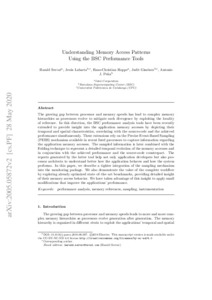Mostra el registre d'ítem simple
Understanding memory access patterns using the BSC performance tools
| dc.contributor.author | Servat, Harald |
| dc.contributor.author | Labarta Mancho, Jesús José |
| dc.contributor.author | Hoppe, Hans-Christian |
| dc.contributor.author | Giménez, Judit |
| dc.contributor.author | Peña, Antonio J. |
| dc.contributor.other | Barcelona Supercomputing Center |
| dc.date.accessioned | 2018-07-24T10:16:13Z |
| dc.date.available | 2020-07-09T00:26:18Z |
| dc.date.issued | 2018-10 |
| dc.identifier.citation | Servat, H. [et al.]. Understanding memory access patterns using the BSC performance tools. "Parallel Computing", Octubre 2018, vol. 78, p. 1-14. |
| dc.identifier.issn | 0167-8191 |
| dc.identifier.other | https://arxiv.org/abs/2005.05872 |
| dc.identifier.uri | http://hdl.handle.net/2117/119839 |
| dc.description.abstract | The growing gap between processor and memory speeds has lead to complex memory hierarchies as processors evolve to mitigate such divergence by exploiting the locality of reference. In this direction, the BSC performance analysis tools have been recently extended to provide insight into the application memory accesses by depicting their temporal and spatial characteristics, correlating with the source-code and the achieved performance simultaneously. These extensions rely on the Precise Event-Based Sampling (PEBS) mechanism available in recent Intel processors to capture information regarding the application memory accesses. The sampled information is later combined with the Folding technique to represent a detailed temporal evolution of the memory accesses and in conjunction with the achieved performance and the source-code counterpart. The reports generated by the latter tool help not only application developers but also processor architects to understand better how the application behaves and how the system performs. In this paper, we describe a tighter integration of the sampling mechanism into the monitoring package. We also demonstrate the value of the complete workflow by exploring already optimized state–of–the–art benchmarks, providing detailed insight of their memory access behavior. We have taken advantage of this insight to apply small modifications that improve the applications’ performance. |
| dc.description.sponsorship | This work has been performed in the Intel-BSC Exascale Lab. We would like to thank Forschungszentrum Jülich for the compute time on the Jureca system. This project has received funding from the European Union’s Horizon 2020 research and innovation program under Marie Sklodowska-Curie grant agreement no. 749516. |
| dc.format.extent | 14 p. |
| dc.language.iso | eng |
| dc.publisher | Elsevier |
| dc.subject | Àrees temàtiques de la UPC::Informàtica |
| dc.subject.lcsh | High performance computing |
| dc.subject.other | Performance analysis |
| dc.subject.other | Memory references |
| dc.subject.other | Sampling |
| dc.subject.other | Instrumentation |
| dc.title | Understanding memory access patterns using the BSC performance tools |
| dc.type | Article |
| dc.subject.lemac | Supercomputadors |
| dc.identifier.doi | 10.1016/j.parco.2018.06.007 |
| dc.description.peerreviewed | Peer Reviewed |
| dc.relation.publisherversion | https://www.sciencedirect.com/science/article/pii/S0167819118301911 |
| dc.rights.access | Open Access |
| local.identifier.drac | 23358637 |
| dc.description.version | Postprint (author's final draft) |
| dc.relation.projectid | info:eu-repo/grantAgreement/EC/H2020/749516/EU/Advanced Ecosystem for Broad Heterogeneous Memory Usage/ECO-H-MEM |
| local.citation.publicationName | Parallel Computing |
| local.citation.volume | 78 |
| local.citation.startingPage | 1 |
| local.citation.endingPage | 14 |
Fitxers d'aquest items
Aquest ítem apareix a les col·leccions següents
-
Articles de revista [318]


